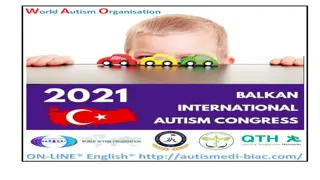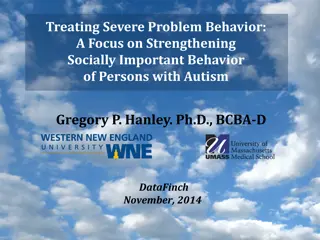Understanding the Role of Board-Certified Behavior Analysts in Supporting Students with Autism in PA School Programs
Pennsylvania Training and Technical Assistance Network (PaTTAN) plays a crucial role in supporting students with autism through the efforts of Board-Certified Behavior Analysts. The increasing number of students eligible for IEPs under the definition of autism necessitates skilled educators who can provide effective instruction. Autism spectrum disorder (ASD) presents complex developmental challenges impacting educational performance, requiring systematic instruction. Applied Behavior Analysis (ABA) has emerged as an evidence-based intervention for students with autism, emphasizing measurable goals and well-defined interventions. ABA is a science devoted to understanding and improving human behavior, aligning with the requirements of IDEA mandates.
Download Presentation

Please find below an Image/Link to download the presentation.
The content on the website is provided AS IS for your information and personal use only. It may not be sold, licensed, or shared on other websites without obtaining consent from the author. Download presentation by click this link. If you encounter any issues during the download, it is possible that the publisher has removed the file from their server.
E N D
Presentation Transcript
The Role of Board-Certified Behavior Analysts in PA Autism Support School Programs PATTAN Harrisburg Autism Initiative Team
PaTTANs Mission The mission of the Pennsylvania Training and Technical Assistance Network (PaTTAN) is to support the efforts and initiatives of the Bureau of Special Education, and to build the capacity of local educational agencies to serve students who receive special education services.
Individuals vary by physiology, by cultural heritage, by past learning experiences . Laws of Learning luckily the laws of learning are the same for all of them!
PDE Child Count Data: Students Eligible for IEPs Under Definition of Autism, Ages 3-21 43,928 40,987 45000 39,754 37,266 40000 35,361 31,19133,187 35000 29,273 27,384 30000 25,177 23,405 21,083 25000 18,879 16,705 20000 14,401 12,323 15000 10,315 8616 10000 7178 5889 4821 4039 3296 2798 5000 2281 15931881 1317 498 0 This increase and the impact on educational performance suggests a need for educators who are skilled in providing effective instruction for students with autism.
Autism spectrum disorder (ASD) is a complex developmental condition that is characterized by: Social communicative deficits Restricted and repetitive patterns of behavior , interests, or activities Examples of challenges and impact on educational performance: Generalization Discrimination Social interactions Require systematic instruction Problem behavior Autism Definition Other such disorders or disabilities may also present with similar deficits 5
Evidence for effective instructional methods for students with autism has accumulated. Autism Initiative and Applied Behavior Analysis ABA: most evidence based conceptual framework for autism interventions NAC Standards Project, 2009; University of North Carolina, Frank Porter Graham Center, 2018 ABA is a conceptual model consistent with effective instruction Pennsylvania has recognized the importance of instructors having competencies in Applied Behavior Analysis- consistent with IDEA mandates for measurable goals and clearly defined interventions) What is ABA? A science devoted to the understanding and improvement of human behavior. ~Cooper, Heron & Heward We rely on interventions from this science to assess/analyze behavior so we can change it for the better! Not exclusive for students with autism
ABA driven by how things that happen in the environment before and after behavior function to alter responding (operant analysis) ABA as a conceptual model Effective instruction is a relation between teacher behavior and student outcomes (independent and dependent variables) and is NOT dependent on any one variable, including place of instruction
Behavior and the Environment Antecedent Behavior What the student does (movement) Consequence Reinforcement: Increases future probability of behavior because things get better (improving conditions ) Positive Negative Motivation (MO) Alters value +-- something is removed after the behavior Alters behavior When things are of value, we behave to get them - something is added after the behavior Observable Measurable Schedules of Reinforcement: Continuous Discriminative Stimulus (SD) happens after every response best to teach new behavior prone to extinction Signals availability of reinforcement Can include multiple events Intermittent happens after some responses best to maintain behavior resistant to extinction Prompts Additional things we do to ensure behavior will occur Extinction reinforcement no longer happens behavior fades initial increase in magnitude and variability of responses Punishment: Decreases future probability of behavior
Assist in-service special education teachers in extending effective educational practices Wide scale training model across Pennsylvania: voluntary participation Components Pre-service competency-based training Explicit site review detailing implementation of objective criteria On site consultation using guided practice model Treatment integrity systems Providing training materials, instructional materials, and support for data systems PAI What we do
Public school settings Across grade levels: Pre-K through Transition from public education Across geographical areas: urban, rural, suburban And school district size (from several hundred students to 10s of thousands of students) Across both typical public-school districts as well as a few charter schools and several Approved Private Schools Where we do it
Student variables: Functional levels Family issues Cultural variables Staff variables Administration Variables Resource availability Regulatory environment Differences of opinion and priority on inclusion/instructional targets/discipline strategies The science behind ABA applications rarely specifies how each of these variables interact in relation to educational outcomes. Other environmental variables that require integration with training and instructional delivery
Centrality of active student responding Data informed decision making Systems organization Space and materials organization Reinforcement of effective repertoires for both staff and students The principle of checking : treatment fidelity Use of established principles:
Competency-Based Intensive Skill Trainings Intensive Skill Training in Applied Behavior Analysis for Teams Supporting Students with Autism ( Boot Camp ) Intermediate and Advanced Verbal Programs for Students with Autism ( Advanced Training ) Establishing Basic Skill Sets for Students with Autism Spectrum Disorders ( Early Learner Training ) Videos and Manuals PATTAN AI ABA Supports Training Model Online resources https://www.pattan.net/Disabilities/Autism Resource file: https://tinyurl.com/PAIResources Mand manual http://www.pattan.net/category/Educational%20Initiatives/Autism/page/Interactive_mand_training_manual.html Access to Developments in Field of Autism/ABA National Autism Conference (in conjunction with Penn State University) http://autism.outreach.psu.edu/ Site Review Guides consultation and local training Allows assessment of consultation effectiveness On site focused consultation (Average 1-2 per month) Modeling and practice with performance feedback Consultation notes Treatment Fidelity
Autism Initiative Supports Assessments Staff Training/ Treatment Fidelity Program/ Target Selection LRE An Integrated System of Effective Instruction Family Engagement Teaching Procedures Data Systems Organization (materials, environment, time)
Site Review: Overview Instruction Mand Intensive teaching Natural Environment Training Vocal training ADLs Direct Instruction and group instruction Fluency Social Skills Behavior Interventions to reduce problem behavior FBA Implementation (data, treatment integrity, implemented as written, staff training, etc.) Plan design (reduce motivation, teach competing response, extinction) Classroom Organization Schedules Classroom environment Materials Data: student notebooks Consultation/Training Inclusive Practices Family Engagement
Intensive Behavioral Health Services (IBHS) Funded by DHS Individualized mental health services provided in the home, school, or community in effect since October 2019 Based on medical necessity criteria Formerly Wraparound Behavioral Health Rehabilitation Services (BHRS) 16
Individual services which provides services to one child. Applied Behavior Analysis (ABA) which is a specific behavioral approach to services. Group services which are most often provided to multiple children at a specific place. Evidence-based treatment (EBT) behavioral health therapies that use scientifically established methods. These can be delivered through individual services, ABA services, and group services. IBHS Services 17
Asst. BC-ABA Assistant behavior consultation-applied behavior analysis BA Behavior analytic BC Behavior consultation BC-ABA Behavior consultation-applied behavior analysis BHT Behavioral health technician BHT-ABA Behavioral health technician- applied behavior analysis MT Mobile therapy IBHS Services 18
BCaBA Board-certified assistant behavior analyst BCAT Board-certified autism technician BCBA Board-certified behavior analyst RBT Registered behavior technician Board Certification 19
Thank You for Your Participation!!! Amiris Dipuglia adipuglia@pattan.net























